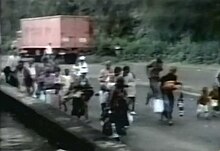
Back الحرب الأهلية البوروندية Arabic شەڕی نێوخۆییی بوروندی CKB Εμφύλιος πόλεμος του Μπουρούντι Greek Burunda enlanda milito Esperanto Guerra civil de Burundi Spanish Burundiko Gerra Zibila Basque Burundin sisällissota Finnish Guerre civile burundaise French מלחמת האזרחים בבורונדי HE Borgarastyrjöldin í Búrúndí Icelandic
| Burundian Civil War | ||||||||
|---|---|---|---|---|---|---|---|---|
| Part of the spillovers of the Rwandan genocide, First and Second Congo Wars | ||||||||
 People fleeing during 1993 Burundian genocide that marked the civil war's start | ||||||||
| ||||||||
| Belligerents | ||||||||
International peacekeepers: |
Ethnic Hutu rebels: Hutu militias and youth gangs:
FDLR[3] Mai-Mai[3] Supported by: |
RPF (Rwanda) | ||||||
| Commanders and leaders | ||||||||
|
Sylvie Kinigi Cyprien Ntaryamira † Sylvestre Ntibantunganya Pierre Buyoya Domitien Ndayizeye Jean Bikomagu |
CNDD-FDD: Léonard Nyangoma Jean-Bosco Ndayikengurukiye Pierre Nkurunziza Évariste Ndayishimiye PALIPEHUTU-FNL:[1] Kabora Kossan Agathon Rwasa Alain Mugabarabona FROLINA: Joseph Karumba[5] |
Committee of Public Salvation (1993) Diomède Rutamucero (PA-Amasekanya) | ||||||
| Strength | ||||||||
|
Gov. forces:
ONUB: 6,095[6] |
c. 11,000 (CNDD-FDD)[2] 2,000–3,000 (PALIPEHUTU-FNL)[2] | Unknown | ||||||
| Casualties and losses | ||||||||
| c. 300,000 killed in total[7] | ||||||||
The Burundian Civil War was a civil war in Burundi lasting from 1993 to 2005. The civil war was the result of longstanding ethnic divisions between the Hutu and the Tutsi ethnic groups. The conflict began following the first multi-party elections in the country since its independence from Belgium in 1962, and is seen as formally ending with the swearing-in of President Pierre Nkurunziza in August 2005. Children were widely used by both sides in the war.[8] The estimated death toll stands at 300,000.[7]
- ^ a b Lansford (2017), p. 225.
- ^ a b c Ngaruko & Nkurunziza (2005), p. 49.
- ^ a b Prunier (2009), pp. 298–299.
- ^ Prunier (2009), p. 288.
- ^ "Buyoya meets FRODEBU, FROLINA leaders". IRIN. 6 September 2001. Retrieved 4 December 2018.
- ^ UN Missions | ONUB
- ^ a b "Heavy shelling in Burundi capital". BBC News. April 18, 2008. Retrieved April 27, 2010.
- ^ Coalition to Stop the Use of Child Soldiers (now Child Soldiers International) (2008). Child Soldiers Global Report 2008 (Burundi). London. pp. 77–81. Archived from the original on 2018-10-10. Retrieved 2018-05-22.
{{cite book}}: CS1 maint: location missing publisher (link)
Cite error: There are <ref group=lower-alpha> tags or {{efn}} templates on this page, but the references will not show without a {{reflist|group=lower-alpha}} template or {{notelist}} template (see the help page).